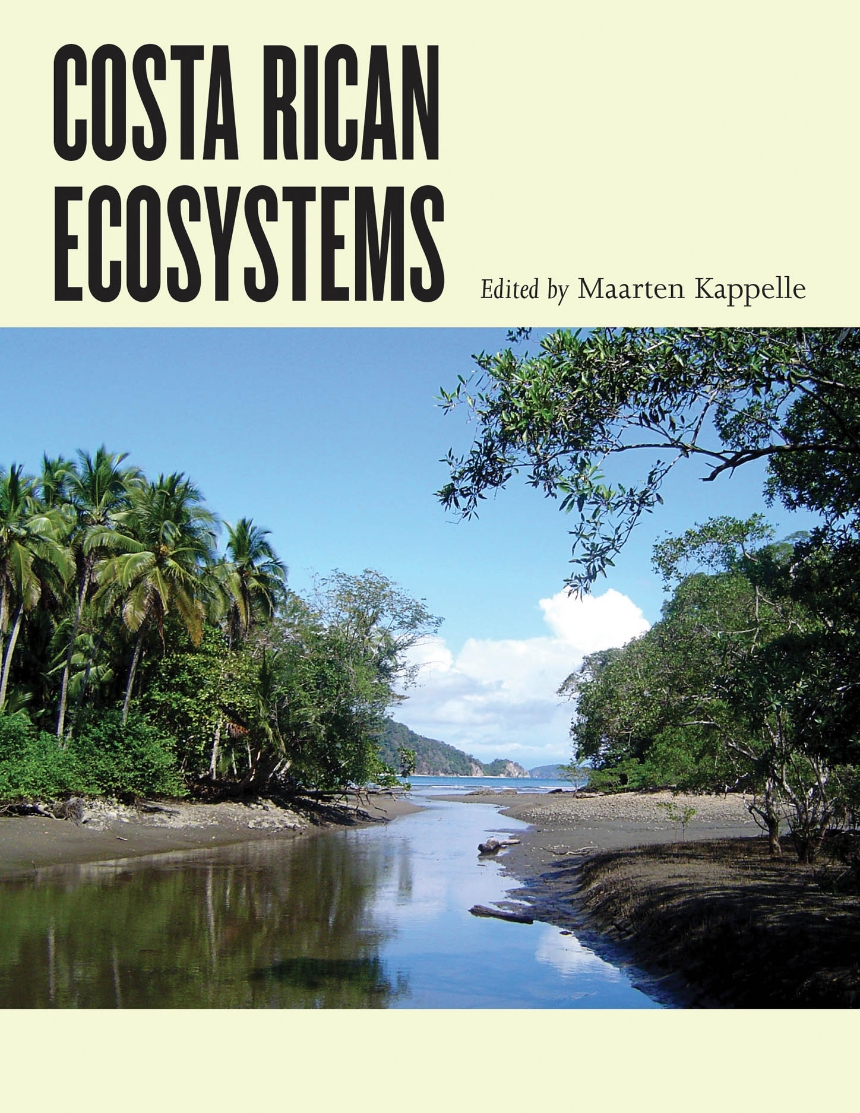Costa Rican Ecosystems
In Costa Rican Ecosystems, Maarten Kappelle brings together a collection of the world’s foremost experts on Costa Rican ecology—outstanding scientists such as Daniel H. Janzen, Jorge Cortés, Jorge A. Jiménez, Sally P. Horn, Robert O. Lawton, Quírico Jiménez M., Carlos Manuel Rodríguez, Catherine M. Pringle, and Eduardo Carrillo J., among others—to offer the first comprehensive account of the diversity, structure, function, uses, and conservation of Costa Rica’s ecosystems. Featuring a foreword and introductory remarks by two renowned leaders in biodiversity science and ecological conservation, Thomas E. Lovejoy and Rodrigo Gámez Lobo, in addition to chapters highlighting the geology, soils, and climate of Costa Rica, as well as the ecosystems of its terrestrial, freshwater, and marine habitats, and including previously unpublished information on Isla del Coco, this beautiful color-illustrated book will be an essential reference for academic scientists, students, natural history guides, conservationists, educators, park guards, and visitors alike.
744 pages | 244 color plates, 82 halftones, 10 line drawings, 25 tables | 8 1/2 x 11 | © 2016
Biological Sciences: Conservation, Ecology, Evolutionary Biology, Natural History
Reviews
Table of Contents
(i) Dedication
(ii) List of Contributors
(iii) Foreword
Thomas E. Lovejoy
(iv) Presentation
Rodrigo Gámez Lobo
(v) Preface
Maarten Kappelle
Part I. Introduction
1. Costa Rica’s Ecosystems: Setting the Stage
Maarten Kappelle
Part II. The Physical Environment
2. Climate of Costa Rica
Wilberth Herrera
3. Geology and Tectonic Geomorphology of Costa Rica: A Natural History Approach
Guillermo E. Alvarado and Guaria Cárdenes
4. Soils of Costa Rica: An Agroecological Approach
Alfredo Alvarado and Rafael Mata
Part III. The Pacific Ocean and Isla del Coco
5. The Pacific Coastal-Marine Ecosystem
Jorge Cortés
6. The Gulf of Nicoya Estuarine Ecosystem
José A. Vargas
7. Isla del Coco: Coastal and Marine Ecosystems
Jorge Cortés
8. Isla del Coco: Terrestrial Ecosystems
Michel Montoya
Part IV. The Northern Pacific Dry Lowlands
9. The Northern Pacific Lowland Seasonal Dry Forests of Guanacaste and the Nicoya Peninsula
Quírico Jiménez M., Eduardo Carrillo J., and Maarten Kappelle
10. Biodiversity Conservation History and Future in Costa Rica: The Case of Área de Conservación Guanacaste (ACG)
Daniel H. Janzen and Winnie Hallwachs
Part V. The Central and Southern Pacific Seasonally Moist Lowlands and Central Valley
11. The Central Pacific Seasonal Forests of Puntarenas and the Central Valley
Quírico Jiménez M. and Eduardo Carrillo J.
12. The Southern Pacific Lowland Evergreen Moist Forest of the Osa Region
Lawrence E. Gilbert, Catherine Christen, Mariana Altrichter, John T. Longino, Peter M. Sherman, Rob Plowes, Monica B. Swartz, Kirk O. Winemiller, Jennifer A. Weghorst, Andres Vega, Pamela Phillips, Christopher Vaughan, and Maarten Kappelle
Part VI. The Moist and Clouded Highlands
13. The Montane Cloud Forests of the Volcanic Cordilleras
Robert O. Lawton, Marcy F. Lawton, R. Michael Lawton, and James D. Daniels
14. The Montane Cloud Forests of the Cordillera de Talamanca
Maarten Kappelle
15. The Páramo Ecosystem of Costa Rica’s Highlands
Maarten Kappelle and Sally P. Horn
Part VII. The Wet Caribbean Lowlands
16. The Caribbean Lowland Evergreen Moist and Wet Forests
Deedra McClearn, Enrique Castro, Ronald C. Coleman, Javier F. Espeleta, Carlos García-Robledo, Alex Gilman, José González, Armond T. Joyce, Erin Kuprewicz, John T. Longino, Nicole L. Michel, Carlos Manuel Rodríguez, Andrea Romero, Carlomagno Soto, Orlando Vargas, Amanda Wendt, Steven Whitfield, and Robert M. Timm
Part VIII. The Caribbean Sea and Shore
17. The Caribbean Coastal and Marine Ecosystems
Jorge Cortés
Part IX. The Rivers, Lakes, and Wetlands
18. Rivers of Costa Rica
Catherine M. Pringle, Elizabeth P. Anderson, Marcelo Ardón, Rebecca J. Bixby, Scott Connelly, John H. Duff, Alan P. Jackman, Pia Paaby, Alonso Ramírez, Gaston E. Small, Marcia N. Snyder, Carissa N. Ganong, and Frank J. Triska
19. Lakes of Costa Rica
Sally P. Horn and Kurt A. Haberyan
20. Bogs, Marshes and Swamps of Costa Rica
Jorge A. Jiménez
Part X. Conclusion
21. Costa Rican Ecosystems: A Brief Summary
Maarten Kappelle
Subject Index
Systematic Index of Common Names
Systematic Index of Scientific Names
